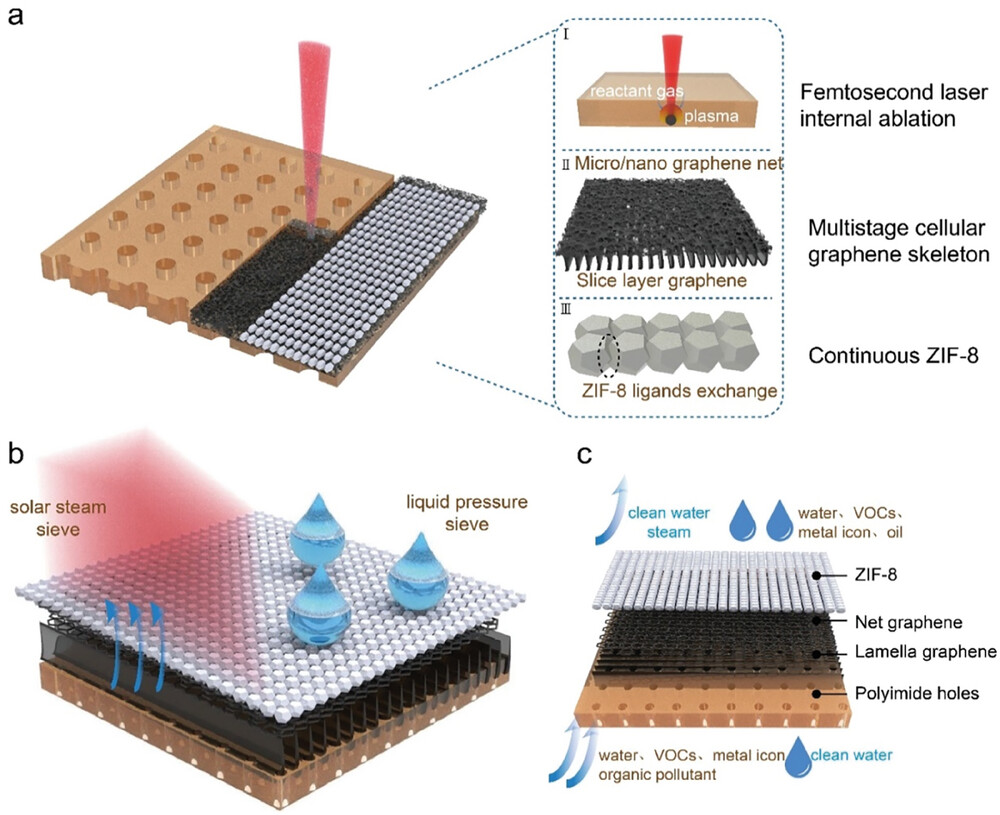| Nov 16, 2023 |
| |
|
(Nanowerk Spotlight) The growing global water crisis poses a severe threat to human health worldwide. With water pollution from toxic contaminants like dyes, heavy metals, and volatile organic compounds worsening, innovative solutions are needed to treat and purify water for human use and environmental remediation. Membrane-based filtration has shown promise, but current materials face limitations in stability, cost, and contaminant removal range.
|
|
Now, researchers from Wuhan University and Purdue University have developed a novel hybrid membrane that integrates graphene and metal organic frameworks (MOFs) to overcome these challenges. Their findings, published in Advanced Functional Materials (“Synergistic Multilevel Sieving Membranes: Integrating Cellular Graphene Skeleton with Continuous MOFs Nanolayer for Superior Multiphase Water Separation”), demonstrate a graphene-MOF membrane that can efficiently sieve a wide spectrum of water contaminants while remaining stable under filtration conditions.
|
 |
| Laser induced multilevel cellular graphene skeleton with continuous MOFs nanolayer (CMN) for multiphase water molecular sieve. a) Schematic of the femtosecond laser induced multilevel graphene skeleton sieve and the concrete details. I) Femtosecond laser internal ablative and thermal shock. II) Laser induced multilevel graphene skeleton. III) In situ growth and ligand exchange of MOFs, using ZIF-8. b) Schematic of the molecular sieve in c) Multiphase water molecular sieving schematic diagram. (Reprinted with permission by Wiley-VCH Verlag)
|
|
Membrane-based water treatment utilizes porous films to filter out contaminants and purify water through selective sieving. MOFs, a class of porous nanomaterials, show impressive molecular sieving ability, but their application has been restricted by limited sieving range, solution instability, and complex processing requirements. Graphene offers high solar absorption and permeability but lacks the selective sieving capabilities of MOFs.
|
|
The new study tackles these limitations by integrating laser-induced graphene (LIG) and continuous MOF layers into a robust hybrid membrane. LIG fabrication utilizes a femtosecond laser to induce graphene formation inside a commercial polymer film, generating a multilevel “graphene skeleton” (MGKS) with micro/nanopores ideal for water treatment. Researchers then grew a continuous nanolayer of MOF particles (ZIF-8) within the LIG skeleton through in situ hydrothermal synthesis. The resulting multilayered membrane combines the strengths of both materials – LIG provides a stable backbone with excellent solar absorption and water permeability, while the MOF layer enables precise molecular sieving.
|
|
The resulting MGKS exhibits ordered micro and nanopores on its surface, key for selective molecule sieving. The laser also forms staggered lamellae on the bottom, facilitating efficient multiphase water flow. To reinforce the graphene’s stability under filtration conditions, the researchers grew a continuous nanolayer of the MOF ZIF-8 throughout the skeleton via in-situ nucleation and ligand exchange. The customized ZIF-8 synthesis yielded smaller nanopores that help sieve smaller contaminants.
|
|
This graphene-MOF hybrid membrane employs a multilevel, multipore size sieving strategy. The micron graphene network adsorbs oils and large molecules. Its 10 nm nanopores provide a large surface area for capturing contaminants. Embedded functional groups like hydroxyls and carboxyls reduce heavy metal ions in the feed water. Finally, the ultrasmall 0.34 nm ZIF-8 pores filter out volatile organic compounds while allowing water to pass through.
|
|
Rigorous materials characterization validated the hybrid membrane’s composition and properties. Tests showed the optimized LIG structure possessed high crystallinity and thermal stability needed for real-world use. The MOF layer filled defects in the graphene skeleton, improving membrane integrity. These results indicated the membrane could maintain performance under the harsh conditions of industrial water treatment.
|
|
Testing validated the membrane’s solar steam generation and contaminant removal performance. It achieved exceptional sunlight absorption and 90% benchmark evaporation efficiency under varied irradiation, while effectively sieving four heavy metal ions below drinking water standards. The ZIF-8 layer also completely intercepted organic dyes and significantly removed volatile organic solvents.
|
|
Under pressure-driven liquid filtration, the membrane’s hydrophobic and lipophilic properties enabled oil-water separation. It adsorbed the entire oil fraction when filtering an oil-water mixture. Though less efficient than solar-driven filtration, pressure-driven operation still reduced volatile organics, heavy metals, and dyes to an appreciable degree.
|
|
Overall, the optimized graphene skeleton’s stability and the ZIF-8’s selective sieving combined to eliminate a wide spectrum of water contaminants. This overcomes limitations of previous graphene and MOF membranes alone. The facile fabrication method also enables scalable production.
|
|
This research pioneers an exciting new direction in membrane technology. The facile LIG-MOF fabrication method and exceptional performance open doors for graphene/MOF hybrids to fulfill their promise in real-world water purification. While some limitations remain, especially for liquid-phase applications, the solar-driven results are extremely promising.
|
|
With further optimization, the approach could expand water treatment capabilities and enable sustainable utilization of non-traditional sources. As the authors note, adjusting laser parameters and MOF selection provides flexibility to tailor the membrane’s structure for desired applications. The scalability of the process is also a major advantage over conventional nanomaterial fabrication techniques.
|

By
Michael
Berger
– Michael is author of three books by the Royal Society of Chemistry:
Nano-Society: Pushing the Boundaries of Technology,
Nanotechnology: The Future is Tiny, and
Nanoengineering: The Skills and Tools Making Technology Invisible
Copyright ©
Nanowerk LLC
|
|
|
- SEO Powered Content & PR Distribution. Get Amplified Today.
- PlatoData.Network Vertical Generative Ai. Empower Yourself. Access Here.
- PlatoAiStream. Web3 Intelligence. Knowledge Amplified. Access Here.
- PlatoESG. Carbon, CleanTech, Energy, Environment, Solar, Waste Management. Access Here.
- PlatoHealth. Biotech and Clinical Trials Intelligence. Access Here.
- Source: https://www.nanowerk.com/spotlight/spotid=64065.php





